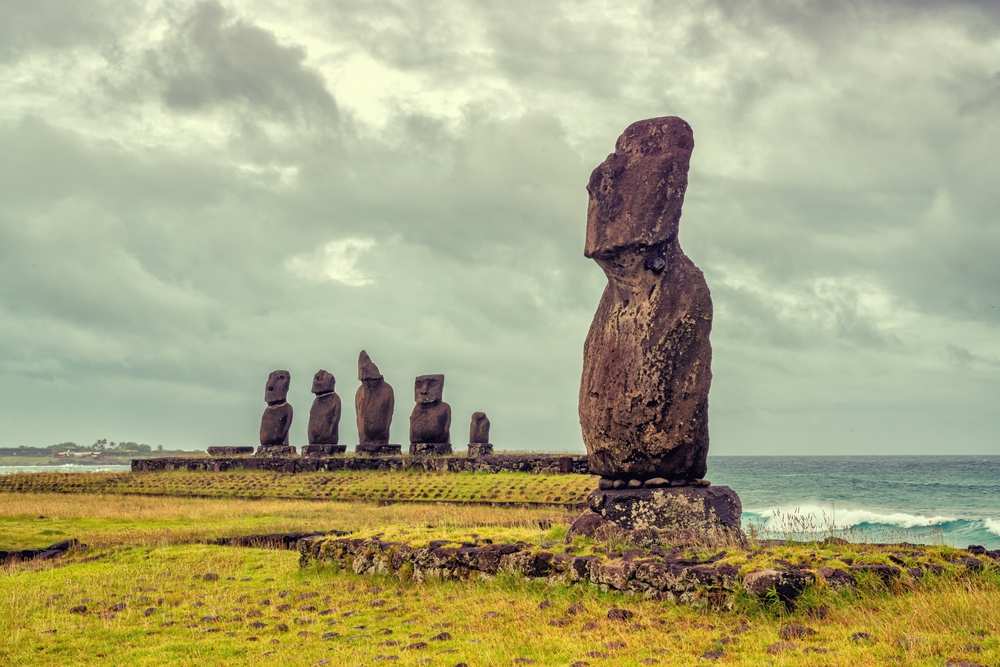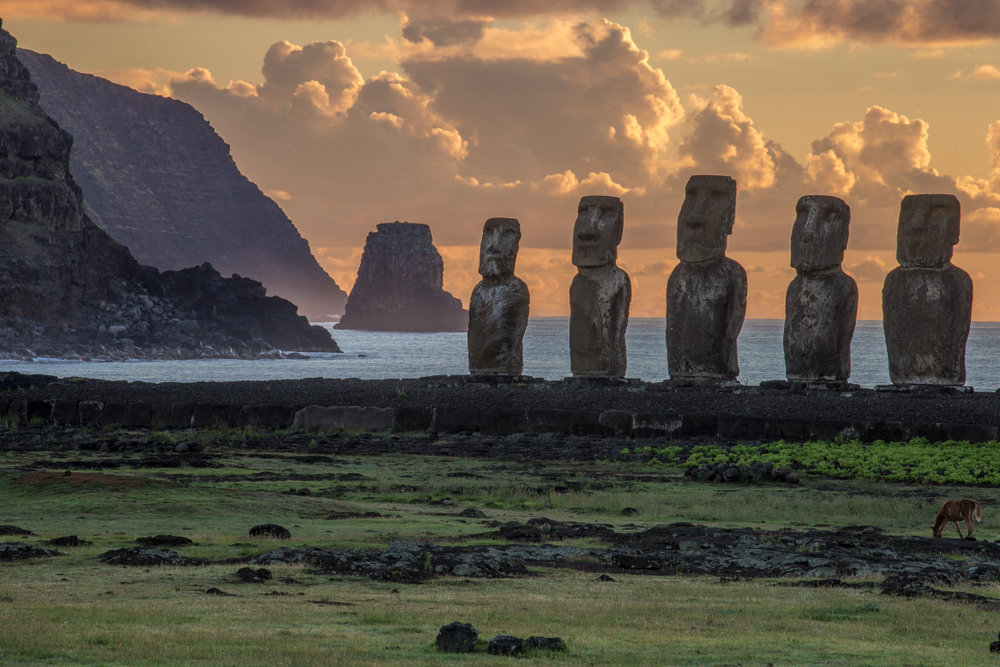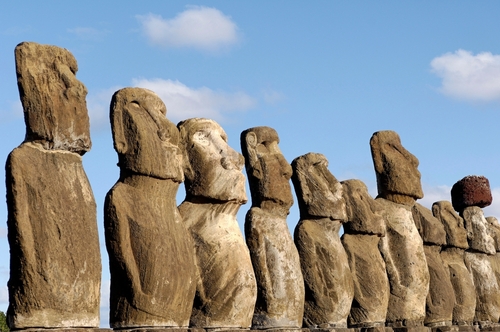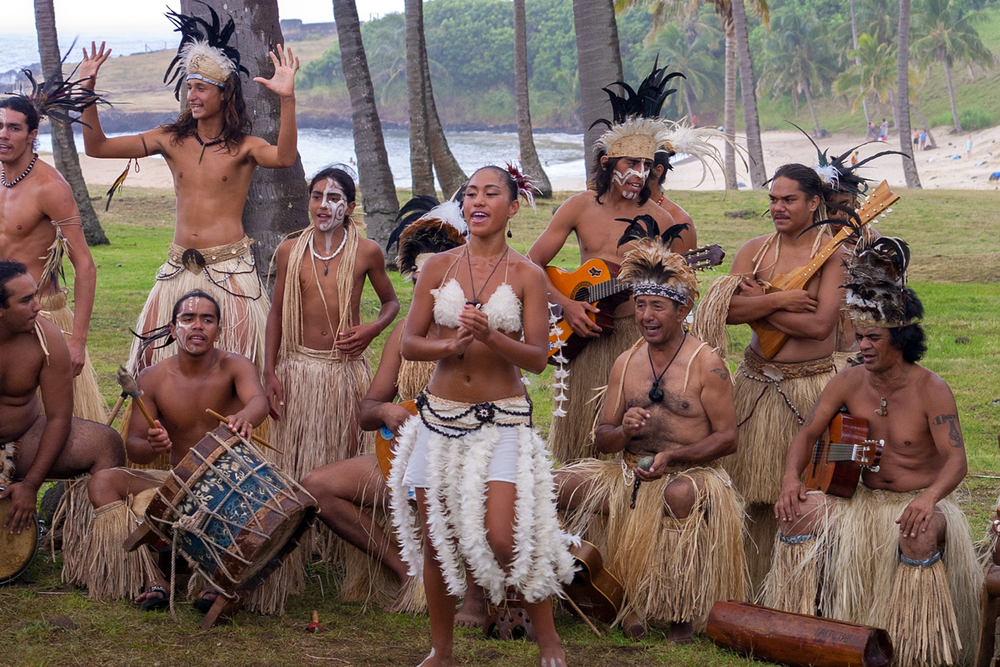Your cart is currently empty!
Scientists Uncover How Easter Island’s Enigmatic Statues ‘Walked’ Across the Island 900 Years Ago

The world has always been captivated by mysteries — those silent, ancient puzzles left behind by civilizations that thrived long before us. The towering pyramids of Giza, the intricate geometry of Stonehenge, the lost city of Machu Picchu — all stand as echoes of human ambition and ingenuity. Yet one of the most haunting enigmas lies in the middle of the Pacific Ocean: Easter Island, or Rapa Nui, a place so remote that its nearest inhabited neighbor lies more than a thousand miles away. Scattered across its windswept plains stand hundreds of Moai statues — enormous stone figures with elongated heads and solemn gazes, seemingly watching over the island and its people. For centuries, they’ve inspired wonder and confusion in equal measure. How did a small Polynesian community carve and move such massive monuments without the help of wheels, animals, or modern machinery?
Now, researchers believe they finally have the answer. A team led by Professor Carl Lipo of Binghamton University and Professor Terry Hunt of the University of Arizona has uncovered compelling evidence suggesting that these colossal statues “walked” to their final resting places. Through a careful blend of experimental archaeology, physics, and cultural study, the scientists have reconstructed how the Rapa Nui people achieved this extraordinary feat nearly 900 years ago. Their findings not only solve one of history’s oldest riddles but also challenge long-held assumptions about this remarkable island civilization — painting a picture not of ecological collapse and overexploitation, but of intelligent design, environmental balance, and profound human cooperation.
Researchers suggest the Moai statues on Easter island were moved upright by rocking them with ropes, allowing them to "walk" to their destinations
— Science girl (@gunsnrosesgirl3) September 14, 2024
📹 Carl Lipo
pic.twitter.com/I5TGN7P3xV
A Monumental Puzzle Beneath the Surface
To the casual observer, Easter Island’s statues appear as gigantic heads emerging from the earth, silent faces peering out toward the horizon. But beneath the surface, archaeologists have discovered full torsos — bodies buried under centuries of sediment, their existence hinting at a story more complex than the one visible on the surface. Each Moai was carved from volcanic tuff, a soft and workable rock found at the island’s Rano Raraku quarry. The quarry itself still bears the marks of ancient craftsmanship — half-finished statues, tools of basalt, and deep channels where stone was meticulously extracted. These statues were not mere decorations; they were sacred embodiments of mana, the spiritual power of the Rapa Nui ancestors, intended to protect and bless the living community.
Between the years 1250 and 1500 CE, nearly 900 statues were created, ranging from modest two-meter figures to colossal monuments weighing up to 80 tons. Yet while the carving techniques could be understood through archaeological evidence, the method of transportation remained elusive for generations. The terrain of Easter Island is rough, uneven, and far from forgiving. Moving a stone of such size across several kilometers without breaking it seemed, by all logical measures, impossible. Early explorers speculated that the statues were dragged on wooden sledges or rolled on logs, a theory that fit the colonial assumption that “primitive” societies relied only on brute force. However, this explanation created new problems. There was no evidence of widespread logging sufficient to support such efforts, and the island’s limited forestation made it unlikely that vast quantities of wood were available for these massive undertakings.
It wasn’t just an engineering puzzle — it was a question that challenged our perception of human capability. The Rapa Nui, often depicted as victims of their own excesses, might instead have been far more sophisticated than outsiders imagined. Every curve, contour, and angle of the statues hinted at intentional design — a sense that their builders understood balance, physics, and motion long before the concept was formalized. The statues seemed to be made not to lie flat or be dragged, but to stand upright — as if they were meant to move on their own.

The Ingenious “Walking” Theory
The breakthrough came when Professors Lipo and Hunt reexamined the Moai not just as monuments but as functional objects shaped with purpose. Their insight was simple but profound: perhaps the Rapa Nui made the statues to move while standing. This would explain their forward-leaning posture and curved bases — design features that make them inherently unstable in a way that allows controlled rocking. Working from this hypothesis, the researchers recreated a full-scale experiment. Their conclusion: the statues could indeed “walk.”
By attaching ropes to each side of a replica Moai and one behind it to stabilize movement, teams could rock the statue side to side, causing it to inch forward. The motion was rhythmic and surprisingly graceful, like a slow, deliberate waddle. “Once you get it moving, it isn’t hard at all — people are pulling with one arm,” Lipo said in his interview with National Geographic. “It conserves energy, and it moves really quickly.” The physics behind it were elegant: each gentle pull shifted the center of gravity just enough to tip the statue forward, while the base pivoted slightly, maintaining balance and momentum.
This discovery completely redefined how experts viewed Rapa Nui engineering. The walking technique didn’t require vast amounts of timber, metal tools, or even hundreds of workers. Instead, it relied on precision, timing, and cooperation. A coordinated team could move a massive statue several hundred meters in under an hour. The Moai’s very form — the rounded base, the narrow top, and the slightly forward tilt — suddenly made perfect sense. They were engineered, not for dragging, but for dancing. And that insight transformed not just archaeology, but our appreciation for the creativity of an island society that understood harmony between design and function centuries before modern engineering was born.

Putting the Theory to the Test
To test the validity of their theory, Lipo and Hunt built a 4.35-ton replica Moai, modeled closely on the originals found at Rano Raraku. Using only ropes and 18 volunteers, the researchers brought the statue to life — and it walked. In just 40 minutes, the replica had traveled 100 meters, guided by alternating tugs from the left and right teams. The statue’s swaying motion, slow but steady, seemed almost alive — an image that perhaps mirrored what the ancient Rapa Nui people would have seen centuries ago as they transported their creations to sacred sites across the island.
The success of this experiment carried enormous implications. Not only did it demonstrate that the statues could have been moved upright, but it also showed that the Rapa Nui’s understanding of physics was highly advanced. Their system used gravity and counterbalance to do most of the work. As Lipo noted, “The physics makes sense. What we saw experimentally actually works. And as it gets bigger, it still works.” The larger the statue, the more stable it became in motion — a paradox that only reinforced the brilliance of the method.
Even the island’s ancient roads support this interpretation. Archaeological surveys show that many pathways are gently curved rather than straight, allowing the walking statues to pivot naturally around bends. These roads often overlap or run parallel, suggesting repeated and intentional use. “We actually see them overlapping each other, and many parallel versions of them,” Lipo explained. “They’re probably clearing a path, moving it, clearing another, and moving it further.” This pattern implies a complex logistical system — one that blended practicality with ceremonial reverence, as each journey likely held spiritual significance.

Reassessing Rapa Nui Ingenuity
For years, the dominant story about Easter Island was one of ecological ruin — a civilization that supposedly destroyed its own environment in a desperate quest to move its statues. But modern science tells a different tale, one not of self-destruction but of resilience and innovation. The “walking” theory offers a model that required minimal resources, avoided widespread deforestation, and emphasized collaboration over consumption. Rather than being a warning of collapse, Easter Island might be a lesson in sustainable engineering and collective intelligence.
This reinterpretation restores dignity to the Rapa Nui people, whose legacy has often been filtered through colonial misunderstandings. They were not reckless or naive; they were resourceful, precise, and profoundly connected to their environment. Their craftsmanship combined practical mechanics with spiritual symbolism — each statue a testament to unity, community, and reverence for their ancestors. By integrating scientific insight with cultural awareness, researchers have begun to see Rapa Nui not as a failed society, but as an example of balance between human ambition and natural constraint.
In a modern world facing its own sustainability challenges, this discovery resonates deeply. The Rapa Nui worked with what they had, transforming physical limitation into a triumph of cooperation and creativity. Their story offers a timeless reminder that progress doesn’t always mean greater complexity — sometimes, it’s about rediscovering simplicity and purpose in harmony with nature.
What Ancient Movement Teaches Modern Minds
The revelation that the Moai “walked” is more than a mechanical breakthrough — it’s a philosophical one. It reshapes how we define progress, intelligence, and innovation. The Rapa Nui didn’t have industrial tools, but they had intuition — an understanding of balance and rhythm that modern science can now explain but not surpass. The act of walking these statues wasn’t just transportation; it was ritual. Each movement connected the people to their gods, their ancestors, and one another, turning physical labor into spiritual art.
This knowledge also challenges the way we view ancient societies. Too often, modern narratives underestimate the technological sophistication of early civilizations. Yet here, in a remote Pacific island society, people achieved feats of precision and coordination that would challenge even contemporary builders. Their success came not from domination over nature but from partnership with it. The statues’ design mirrors this ethos: their motion depended on harmony — too much force, and they’d topple; too little, and they’d remain still. The balance was everything.
In rediscovering this ancient wisdom, modern scientists remind us that ingenuity doesn’t always look like innovation in a lab or factory. It can emerge from understanding the world as it is — using physics, observation, and cooperation to achieve something that endures through the ages. The Moai are a living metaphor for progress rooted in balance, not excess.
The Challenge of Proof and the Beauty of Mystery
Science thrives on curiosity, and Lipo’s team embraces that spirit fully. “Find some evidence that shows it couldn’t be walking,” he said with a smile. His challenge isn’t defensive — it’s an open invitation to the scientific community to test, refine, and build upon their findings. The best discoveries, after all, are those that spark new questions. How were the ropes made? What rituals accompanied each journey? Could variations in statue design correspond to different methods of transport? Each answer uncovers a deeper layer of understanding about the Rapa Nui world.
Even now, mysteries remain. Some researchers suggest that smaller statues might have been moved using different methods, or that environmental shifts altered how routes were chosen. These debates are far from over, but they represent the best of science: the collective pursuit of truth through evidence, discussion, and imagination.
What endures, however, is the sense of awe. The Moai continue to stand as witnesses to a time when creativity and community converged in extraordinary ways. Their “walking” was more than movement — it was expression. It reminds us that humanity’s greatest achievements often begin not with technology, but with belief: that together, we can move what seems immovable. Nine hundred years ago, the people of Rapa Nui did exactly that — and in doing so, they left a message still relevant today. Progress, they showed us, is a walk worth taking, one careful, deliberate step at a time.
